Summary of Statistical Research Methods in Biostatistics HLSC647
VerifiedAdded on 2022/11/11
|9
|2103
|354
Report
AI Summary
This report provides a comprehensive overview of statistical research methods used in biostatistics. It begins with an introduction to the field, highlighting the use of statistical tools for data collection, analysis, and result discussion. The report covers descriptive statistics, including measures like mean and standard deviation, and inferential statistics, which utilizes sample data to draw population inferences. It also discusses different scales of measurement and the use of summation symbols. The report then delves into research planning, emphasizing the importance of defining the problem, reviewing literature, and preparing proposals, including ethical considerations and data collection. The document further explores research ethics, including ethical issues in experimental and non-experimental studies, informed consent, and data integrity. The normal distribution is explained, along with hypothesis testing, standard errors, and correlation and regression analysis. The document provides a detailed analysis of various statistical methods, including Pearson's correlation coefficient and regression techniques, offering insights into their applications and limitations. The report concludes with a list of references used to compile the document.
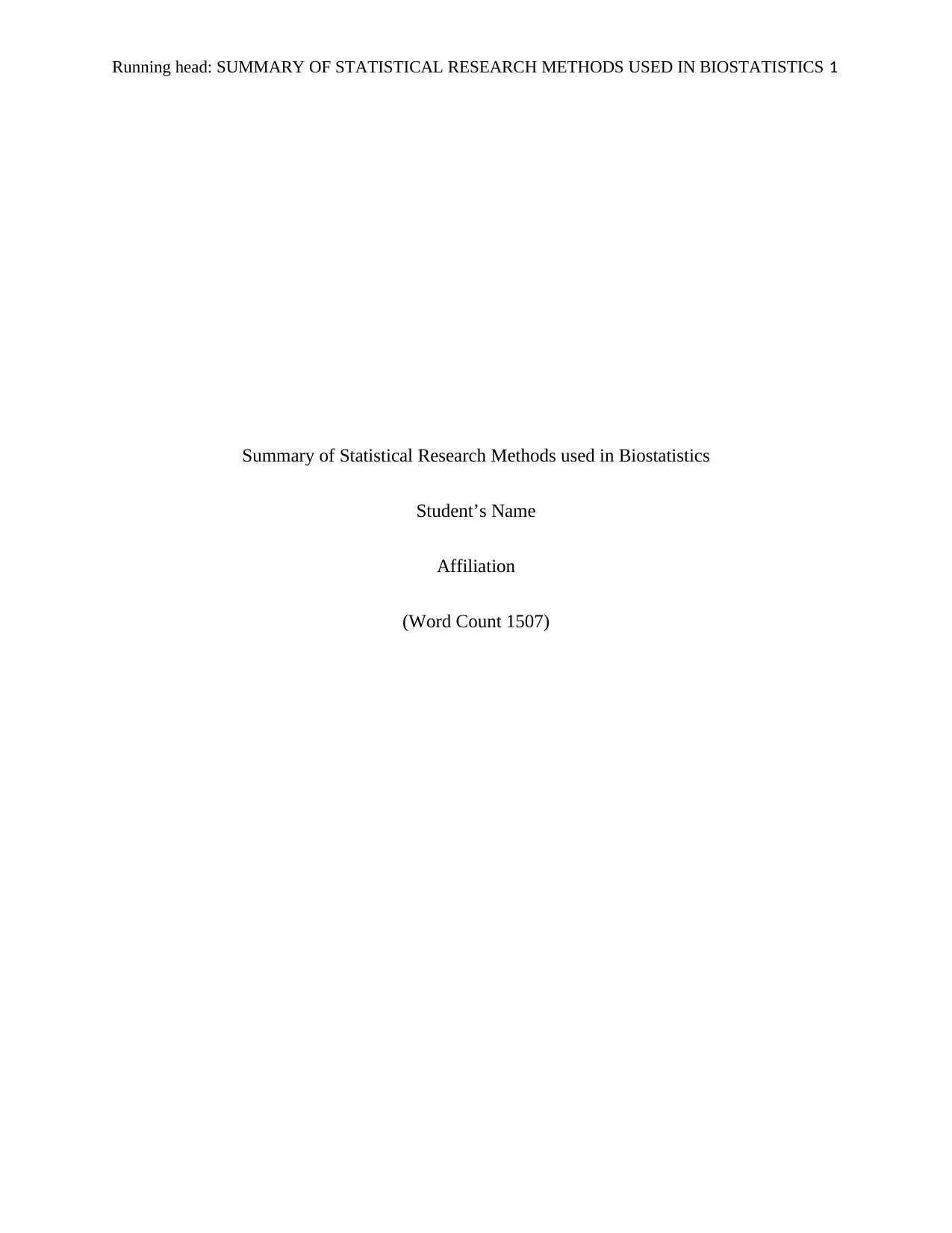
Running head: SUMMARY OF STATISTICAL RESEARCH METHODS USED IN BIOSTATISTICS 1
Summary of Statistical Research Methods used in Biostatistics
Student’s Name
Affiliation
(Word Count 1507)
Summary of Statistical Research Methods used in Biostatistics
Student’s Name
Affiliation
(Word Count 1507)
Paraphrase This Document
Need a fresh take? Get an instant paraphrase of this document with our AI Paraphraser
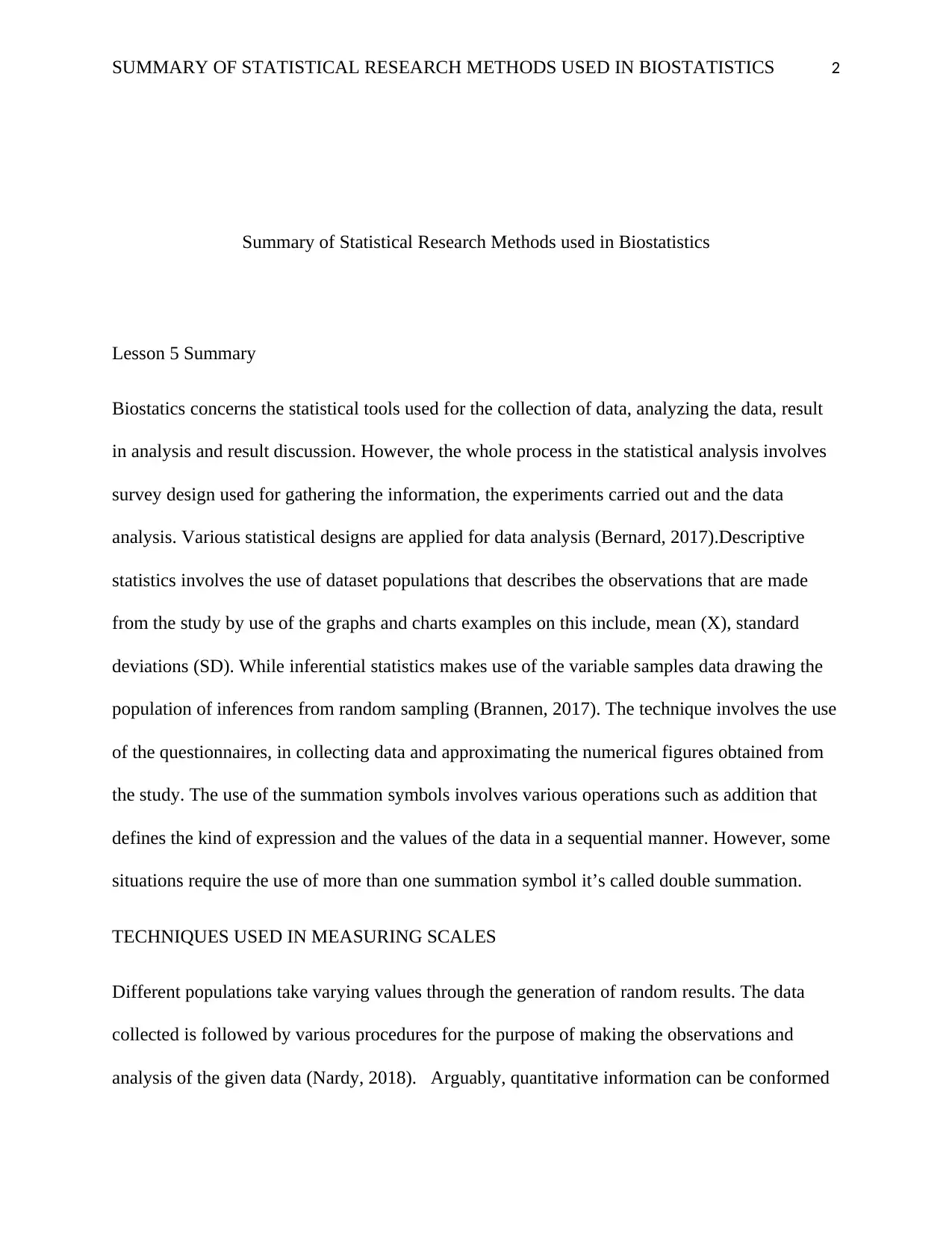
SUMMARY OF STATISTICAL RESEARCH METHODS USED IN BIOSTATISTICS 2
Summary of Statistical Research Methods used in Biostatistics
Lesson 5 Summary
Biostatics concerns the statistical tools used for the collection of data, analyzing the data, result
in analysis and result discussion. However, the whole process in the statistical analysis involves
survey design used for gathering the information, the experiments carried out and the data
analysis. Various statistical designs are applied for data analysis (Bernard, 2017).Descriptive
statistics involves the use of dataset populations that describes the observations that are made
from the study by use of the graphs and charts examples on this include, mean (X), standard
deviations (SD). While inferential statistics makes use of the variable samples data drawing the
population of inferences from random sampling (Brannen, 2017). The technique involves the use
of the questionnaires, in collecting data and approximating the numerical figures obtained from
the study. The use of the summation symbols involves various operations such as addition that
defines the kind of expression and the values of the data in a sequential manner. However, some
situations require the use of more than one summation symbol it’s called double summation.
TECHNIQUES USED IN MEASURING SCALES
Different populations take varying values through the generation of random results. The data
collected is followed by various procedures for the purpose of making the observations and
analysis of the given data (Nardy, 2018). Arguably, quantitative information can be conformed
Summary of Statistical Research Methods used in Biostatistics
Lesson 5 Summary
Biostatics concerns the statistical tools used for the collection of data, analyzing the data, result
in analysis and result discussion. However, the whole process in the statistical analysis involves
survey design used for gathering the information, the experiments carried out and the data
analysis. Various statistical designs are applied for data analysis (Bernard, 2017).Descriptive
statistics involves the use of dataset populations that describes the observations that are made
from the study by use of the graphs and charts examples on this include, mean (X), standard
deviations (SD). While inferential statistics makes use of the variable samples data drawing the
population of inferences from random sampling (Brannen, 2017). The technique involves the use
of the questionnaires, in collecting data and approximating the numerical figures obtained from
the study. The use of the summation symbols involves various operations such as addition that
defines the kind of expression and the values of the data in a sequential manner. However, some
situations require the use of more than one summation symbol it’s called double summation.
TECHNIQUES USED IN MEASURING SCALES
Different populations take varying values through the generation of random results. The data
collected is followed by various procedures for the purpose of making the observations and
analysis of the given data (Nardy, 2018). Arguably, quantitative information can be conformed
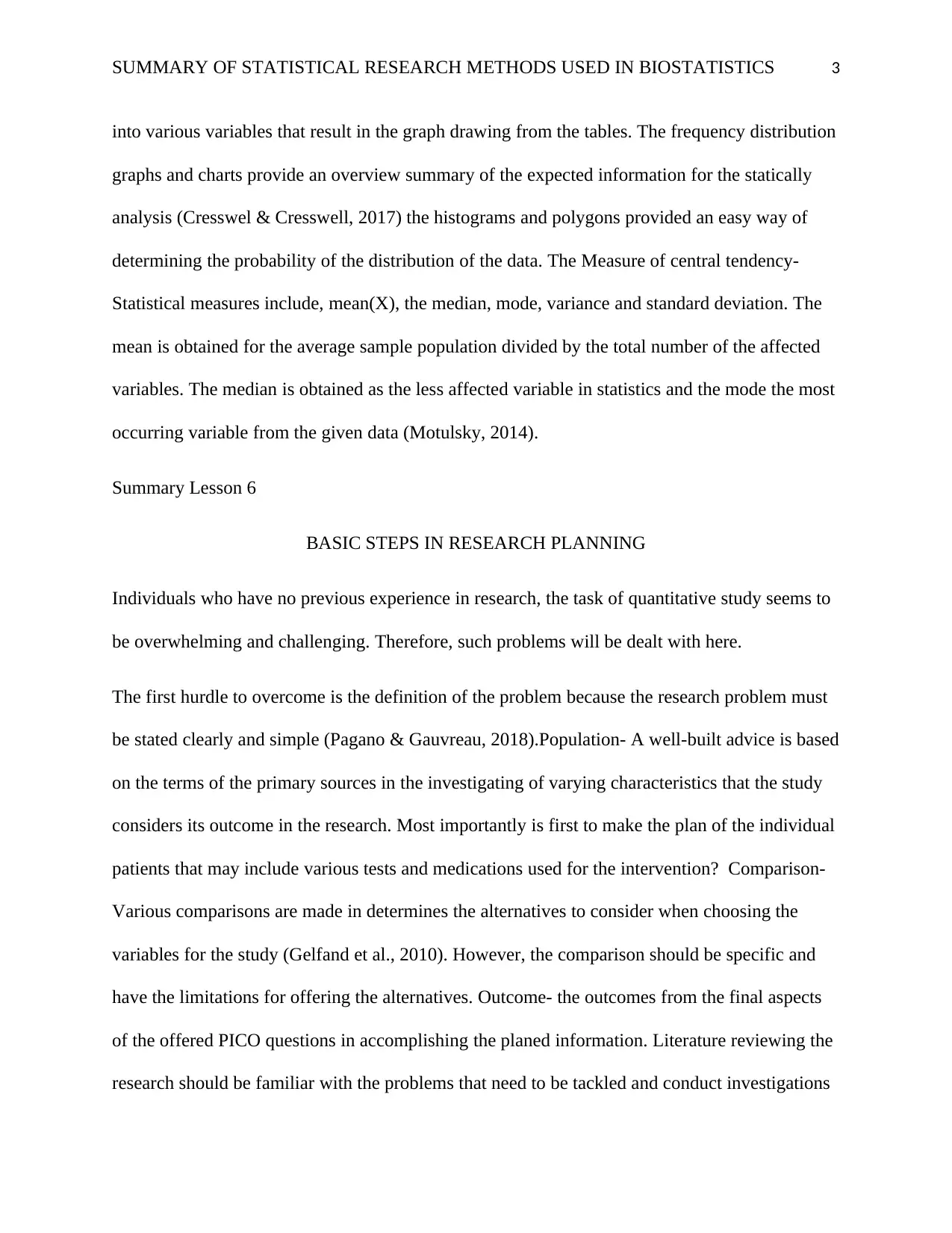
SUMMARY OF STATISTICAL RESEARCH METHODS USED IN BIOSTATISTICS 3
into various variables that result in the graph drawing from the tables. The frequency distribution
graphs and charts provide an overview summary of the expected information for the statically
analysis (Cresswel & Cresswell, 2017) the histograms and polygons provided an easy way of
determining the probability of the distribution of the data. The Measure of central tendency-
Statistical measures include, mean(X), the median, mode, variance and standard deviation. The
mean is obtained for the average sample population divided by the total number of the affected
variables. The median is obtained as the less affected variable in statistics and the mode the most
occurring variable from the given data (Motulsky, 2014).
Summary Lesson 6
BASIC STEPS IN RESEARCH PLANNING
Individuals who have no previous experience in research, the task of quantitative study seems to
be overwhelming and challenging. Therefore, such problems will be dealt with here.
The first hurdle to overcome is the definition of the problem because the research problem must
be stated clearly and simple (Pagano & Gauvreau, 2018).Population- A well-built advice is based
on the terms of the primary sources in the investigating of varying characteristics that the study
considers its outcome in the research. Most importantly is first to make the plan of the individual
patients that may include various tests and medications used for the intervention? Comparison-
Various comparisons are made in determines the alternatives to consider when choosing the
variables for the study (Gelfand et al., 2010). However, the comparison should be specific and
have the limitations for offering the alternatives. Outcome- the outcomes from the final aspects
of the offered PICO questions in accomplishing the planed information. Literature reviewing the
research should be familiar with the problems that need to be tackled and conduct investigations
into various variables that result in the graph drawing from the tables. The frequency distribution
graphs and charts provide an overview summary of the expected information for the statically
analysis (Cresswel & Cresswell, 2017) the histograms and polygons provided an easy way of
determining the probability of the distribution of the data. The Measure of central tendency-
Statistical measures include, mean(X), the median, mode, variance and standard deviation. The
mean is obtained for the average sample population divided by the total number of the affected
variables. The median is obtained as the less affected variable in statistics and the mode the most
occurring variable from the given data (Motulsky, 2014).
Summary Lesson 6
BASIC STEPS IN RESEARCH PLANNING
Individuals who have no previous experience in research, the task of quantitative study seems to
be overwhelming and challenging. Therefore, such problems will be dealt with here.
The first hurdle to overcome is the definition of the problem because the research problem must
be stated clearly and simple (Pagano & Gauvreau, 2018).Population- A well-built advice is based
on the terms of the primary sources in the investigating of varying characteristics that the study
considers its outcome in the research. Most importantly is first to make the plan of the individual
patients that may include various tests and medications used for the intervention? Comparison-
Various comparisons are made in determines the alternatives to consider when choosing the
variables for the study (Gelfand et al., 2010). However, the comparison should be specific and
have the limitations for offering the alternatives. Outcome- the outcomes from the final aspects
of the offered PICO questions in accomplishing the planed information. Literature reviewing the
research should be familiar with the problems that need to be tackled and conduct investigations
⊘ This is a preview!⊘
Do you want full access?
Subscribe today to unlock all pages.

Trusted by 1+ million students worldwide
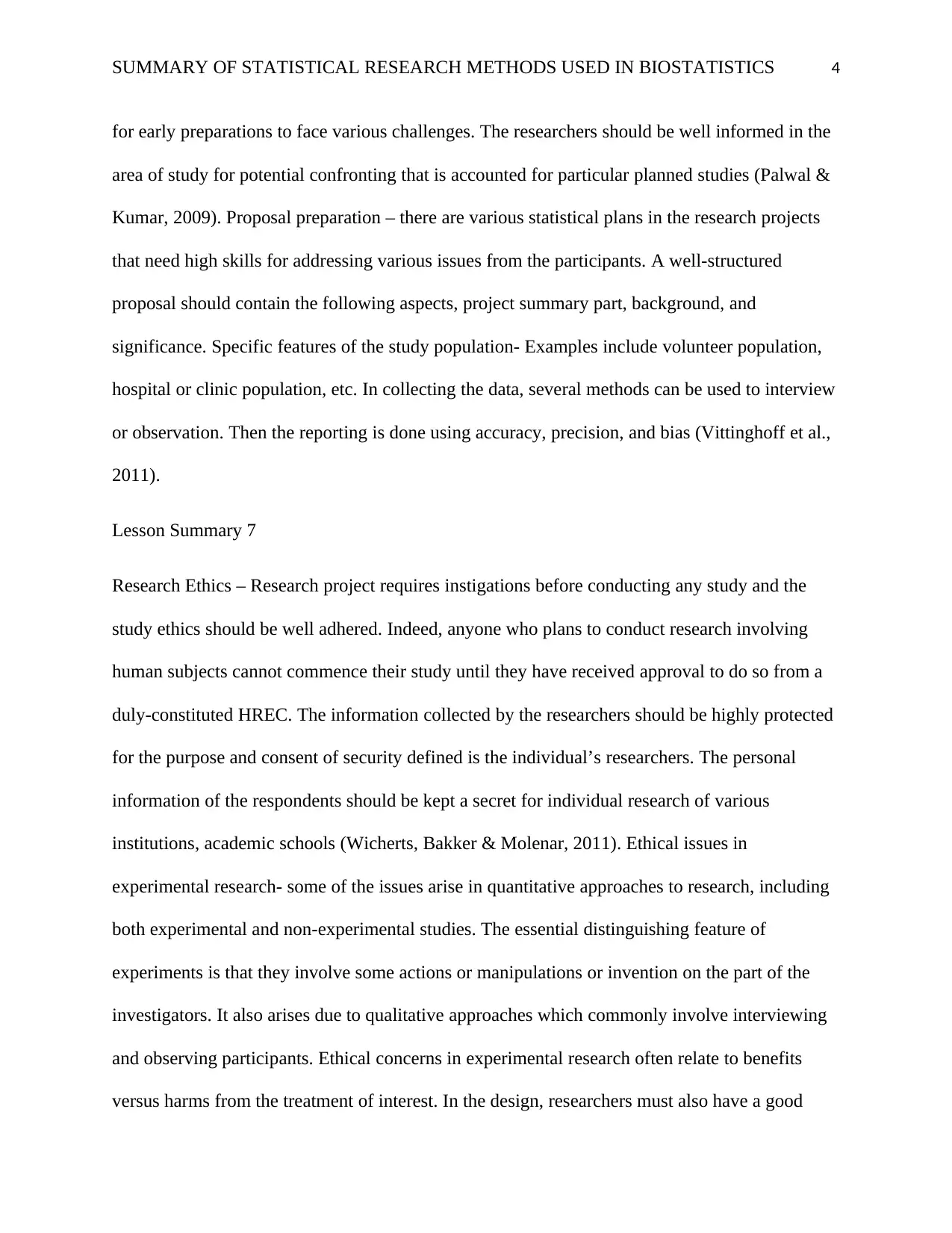
SUMMARY OF STATISTICAL RESEARCH METHODS USED IN BIOSTATISTICS 4
for early preparations to face various challenges. The researchers should be well informed in the
area of study for potential confronting that is accounted for particular planned studies (Palwal &
Kumar, 2009). Proposal preparation – there are various statistical plans in the research projects
that need high skills for addressing various issues from the participants. A well-structured
proposal should contain the following aspects, project summary part, background, and
significance. Specific features of the study population- Examples include volunteer population,
hospital or clinic population, etc. In collecting the data, several methods can be used to interview
or observation. Then the reporting is done using accuracy, precision, and bias (Vittinghoff et al.,
2011).
Lesson Summary 7
Research Ethics – Research project requires instigations before conducting any study and the
study ethics should be well adhered. Indeed, anyone who plans to conduct research involving
human subjects cannot commence their study until they have received approval to do so from a
duly-constituted HREC. The information collected by the researchers should be highly protected
for the purpose and consent of security defined is the individual’s researchers. The personal
information of the respondents should be kept a secret for individual research of various
institutions, academic schools (Wicherts, Bakker & Molenar, 2011). Ethical issues in
experimental research- some of the issues arise in quantitative approaches to research, including
both experimental and non-experimental studies. The essential distinguishing feature of
experiments is that they involve some actions or manipulations or invention on the part of the
investigators. It also arises due to qualitative approaches which commonly involve interviewing
and observing participants. Ethical concerns in experimental research often relate to benefits
versus harms from the treatment of interest. In the design, researchers must also have a good
for early preparations to face various challenges. The researchers should be well informed in the
area of study for potential confronting that is accounted for particular planned studies (Palwal &
Kumar, 2009). Proposal preparation – there are various statistical plans in the research projects
that need high skills for addressing various issues from the participants. A well-structured
proposal should contain the following aspects, project summary part, background, and
significance. Specific features of the study population- Examples include volunteer population,
hospital or clinic population, etc. In collecting the data, several methods can be used to interview
or observation. Then the reporting is done using accuracy, precision, and bias (Vittinghoff et al.,
2011).
Lesson Summary 7
Research Ethics – Research project requires instigations before conducting any study and the
study ethics should be well adhered. Indeed, anyone who plans to conduct research involving
human subjects cannot commence their study until they have received approval to do so from a
duly-constituted HREC. The information collected by the researchers should be highly protected
for the purpose and consent of security defined is the individual’s researchers. The personal
information of the respondents should be kept a secret for individual research of various
institutions, academic schools (Wicherts, Bakker & Molenar, 2011). Ethical issues in
experimental research- some of the issues arise in quantitative approaches to research, including
both experimental and non-experimental studies. The essential distinguishing feature of
experiments is that they involve some actions or manipulations or invention on the part of the
investigators. It also arises due to qualitative approaches which commonly involve interviewing
and observing participants. Ethical concerns in experimental research often relate to benefits
versus harms from the treatment of interest. In the design, researchers must also have a good
Paraphrase This Document
Need a fresh take? Get an instant paraphrase of this document with our AI Paraphraser
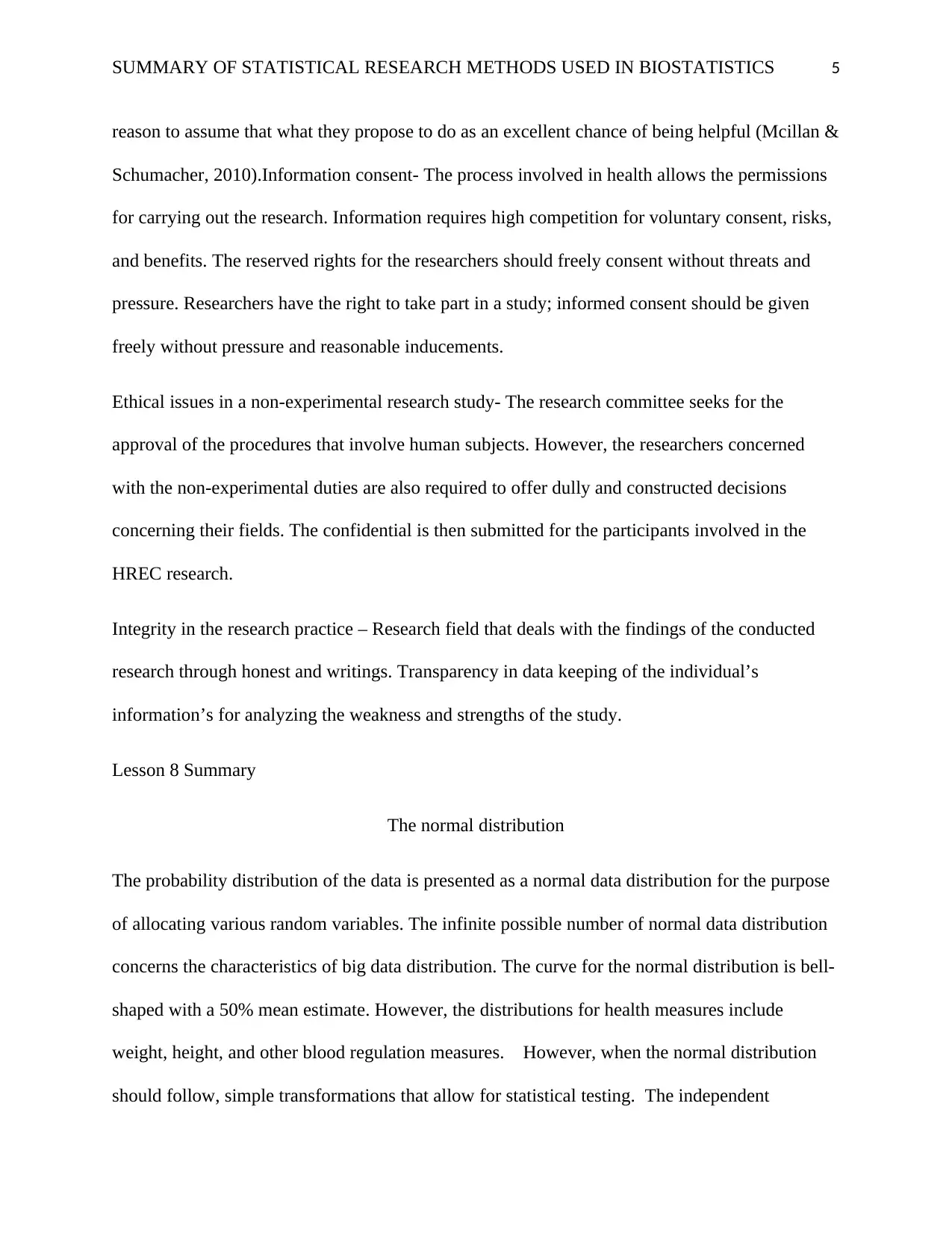
SUMMARY OF STATISTICAL RESEARCH METHODS USED IN BIOSTATISTICS 5
reason to assume that what they propose to do as an excellent chance of being helpful (Mcillan &
Schumacher, 2010).Information consent- The process involved in health allows the permissions
for carrying out the research. Information requires high competition for voluntary consent, risks,
and benefits. The reserved rights for the researchers should freely consent without threats and
pressure. Researchers have the right to take part in a study; informed consent should be given
freely without pressure and reasonable inducements.
Ethical issues in a non-experimental research study- The research committee seeks for the
approval of the procedures that involve human subjects. However, the researchers concerned
with the non-experimental duties are also required to offer dully and constructed decisions
concerning their fields. The confidential is then submitted for the participants involved in the
HREC research.
Integrity in the research practice – Research field that deals with the findings of the conducted
research through honest and writings. Transparency in data keeping of the individual’s
information’s for analyzing the weakness and strengths of the study.
Lesson 8 Summary
The normal distribution
The probability distribution of the data is presented as a normal data distribution for the purpose
of allocating various random variables. The infinite possible number of normal data distribution
concerns the characteristics of big data distribution. The curve for the normal distribution is bell-
shaped with a 50% mean estimate. However, the distributions for health measures include
weight, height, and other blood regulation measures. However, when the normal distribution
should follow, simple transformations that allow for statistical testing. The independent
reason to assume that what they propose to do as an excellent chance of being helpful (Mcillan &
Schumacher, 2010).Information consent- The process involved in health allows the permissions
for carrying out the research. Information requires high competition for voluntary consent, risks,
and benefits. The reserved rights for the researchers should freely consent without threats and
pressure. Researchers have the right to take part in a study; informed consent should be given
freely without pressure and reasonable inducements.
Ethical issues in a non-experimental research study- The research committee seeks for the
approval of the procedures that involve human subjects. However, the researchers concerned
with the non-experimental duties are also required to offer dully and constructed decisions
concerning their fields. The confidential is then submitted for the participants involved in the
HREC research.
Integrity in the research practice – Research field that deals with the findings of the conducted
research through honest and writings. Transparency in data keeping of the individual’s
information’s for analyzing the weakness and strengths of the study.
Lesson 8 Summary
The normal distribution
The probability distribution of the data is presented as a normal data distribution for the purpose
of allocating various random variables. The infinite possible number of normal data distribution
concerns the characteristics of big data distribution. The curve for the normal distribution is bell-
shaped with a 50% mean estimate. However, the distributions for health measures include
weight, height, and other blood regulation measures. However, when the normal distribution
should follow, simple transformations that allow for statistical testing. The independent
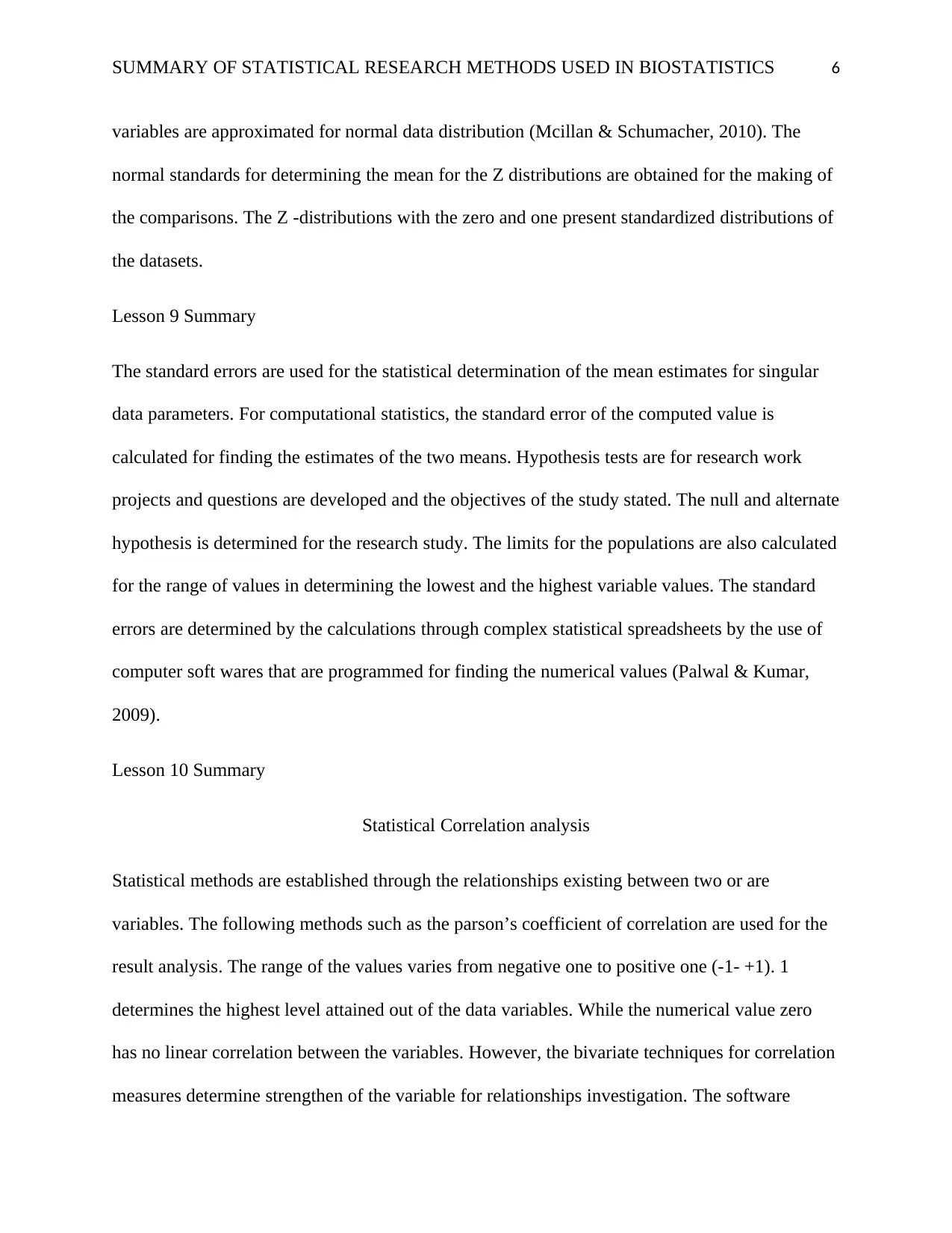
SUMMARY OF STATISTICAL RESEARCH METHODS USED IN BIOSTATISTICS 6
variables are approximated for normal data distribution (Mcillan & Schumacher, 2010). The
normal standards for determining the mean for the Z distributions are obtained for the making of
the comparisons. The Z -distributions with the zero and one present standardized distributions of
the datasets.
Lesson 9 Summary
The standard errors are used for the statistical determination of the mean estimates for singular
data parameters. For computational statistics, the standard error of the computed value is
calculated for finding the estimates of the two means. Hypothesis tests are for research work
projects and questions are developed and the objectives of the study stated. The null and alternate
hypothesis is determined for the research study. The limits for the populations are also calculated
for the range of values in determining the lowest and the highest variable values. The standard
errors are determined by the calculations through complex statistical spreadsheets by the use of
computer soft wares that are programmed for finding the numerical values (Palwal & Kumar,
2009).
Lesson 10 Summary
Statistical Correlation analysis
Statistical methods are established through the relationships existing between two or are
variables. The following methods such as the parson’s coefficient of correlation are used for the
result analysis. The range of the values varies from negative one to positive one (-1- +1). 1
determines the highest level attained out of the data variables. While the numerical value zero
has no linear correlation between the variables. However, the bivariate techniques for correlation
measures determine strengthen of the variable for relationships investigation. The software
variables are approximated for normal data distribution (Mcillan & Schumacher, 2010). The
normal standards for determining the mean for the Z distributions are obtained for the making of
the comparisons. The Z -distributions with the zero and one present standardized distributions of
the datasets.
Lesson 9 Summary
The standard errors are used for the statistical determination of the mean estimates for singular
data parameters. For computational statistics, the standard error of the computed value is
calculated for finding the estimates of the two means. Hypothesis tests are for research work
projects and questions are developed and the objectives of the study stated. The null and alternate
hypothesis is determined for the research study. The limits for the populations are also calculated
for the range of values in determining the lowest and the highest variable values. The standard
errors are determined by the calculations through complex statistical spreadsheets by the use of
computer soft wares that are programmed for finding the numerical values (Palwal & Kumar,
2009).
Lesson 10 Summary
Statistical Correlation analysis
Statistical methods are established through the relationships existing between two or are
variables. The following methods such as the parson’s coefficient of correlation are used for the
result analysis. The range of the values varies from negative one to positive one (-1- +1). 1
determines the highest level attained out of the data variables. While the numerical value zero
has no linear correlation between the variables. However, the bivariate techniques for correlation
measures determine strengthen of the variable for relationships investigation. The software
⊘ This is a preview!⊘
Do you want full access?
Subscribe today to unlock all pages.

Trusted by 1+ million students worldwide
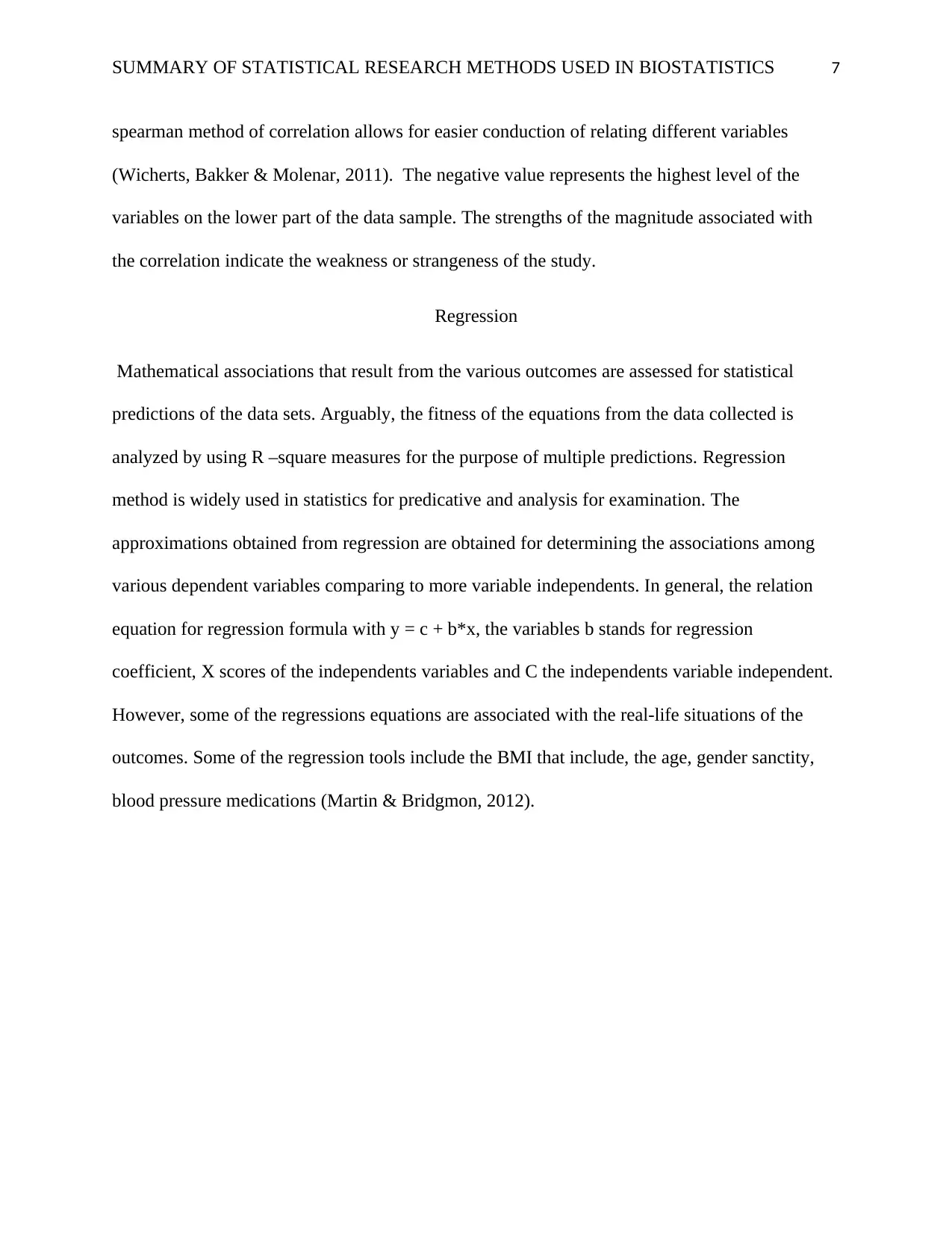
SUMMARY OF STATISTICAL RESEARCH METHODS USED IN BIOSTATISTICS 7
spearman method of correlation allows for easier conduction of relating different variables
(Wicherts, Bakker & Molenar, 2011). The negative value represents the highest level of the
variables on the lower part of the data sample. The strengths of the magnitude associated with
the correlation indicate the weakness or strangeness of the study.
Regression
Mathematical associations that result from the various outcomes are assessed for statistical
predictions of the data sets. Arguably, the fitness of the equations from the data collected is
analyzed by using R –square measures for the purpose of multiple predictions. Regression
method is widely used in statistics for predicative and analysis for examination. The
approximations obtained from regression are obtained for determining the associations among
various dependent variables comparing to more variable independents. In general, the relation
equation for regression formula with y = c + b*x, the variables b stands for regression
coefficient, X scores of the independents variables and C the independents variable independent.
However, some of the regressions equations are associated with the real-life situations of the
outcomes. Some of the regression tools include the BMI that include, the age, gender sanctity,
blood pressure medications (Martin & Bridgmon, 2012).
spearman method of correlation allows for easier conduction of relating different variables
(Wicherts, Bakker & Molenar, 2011). The negative value represents the highest level of the
variables on the lower part of the data sample. The strengths of the magnitude associated with
the correlation indicate the weakness or strangeness of the study.
Regression
Mathematical associations that result from the various outcomes are assessed for statistical
predictions of the data sets. Arguably, the fitness of the equations from the data collected is
analyzed by using R –square measures for the purpose of multiple predictions. Regression
method is widely used in statistics for predicative and analysis for examination. The
approximations obtained from regression are obtained for determining the associations among
various dependent variables comparing to more variable independents. In general, the relation
equation for regression formula with y = c + b*x, the variables b stands for regression
coefficient, X scores of the independents variables and C the independents variable independent.
However, some of the regressions equations are associated with the real-life situations of the
outcomes. Some of the regression tools include the BMI that include, the age, gender sanctity,
blood pressure medications (Martin & Bridgmon, 2012).
Paraphrase This Document
Need a fresh take? Get an instant paraphrase of this document with our AI Paraphraser
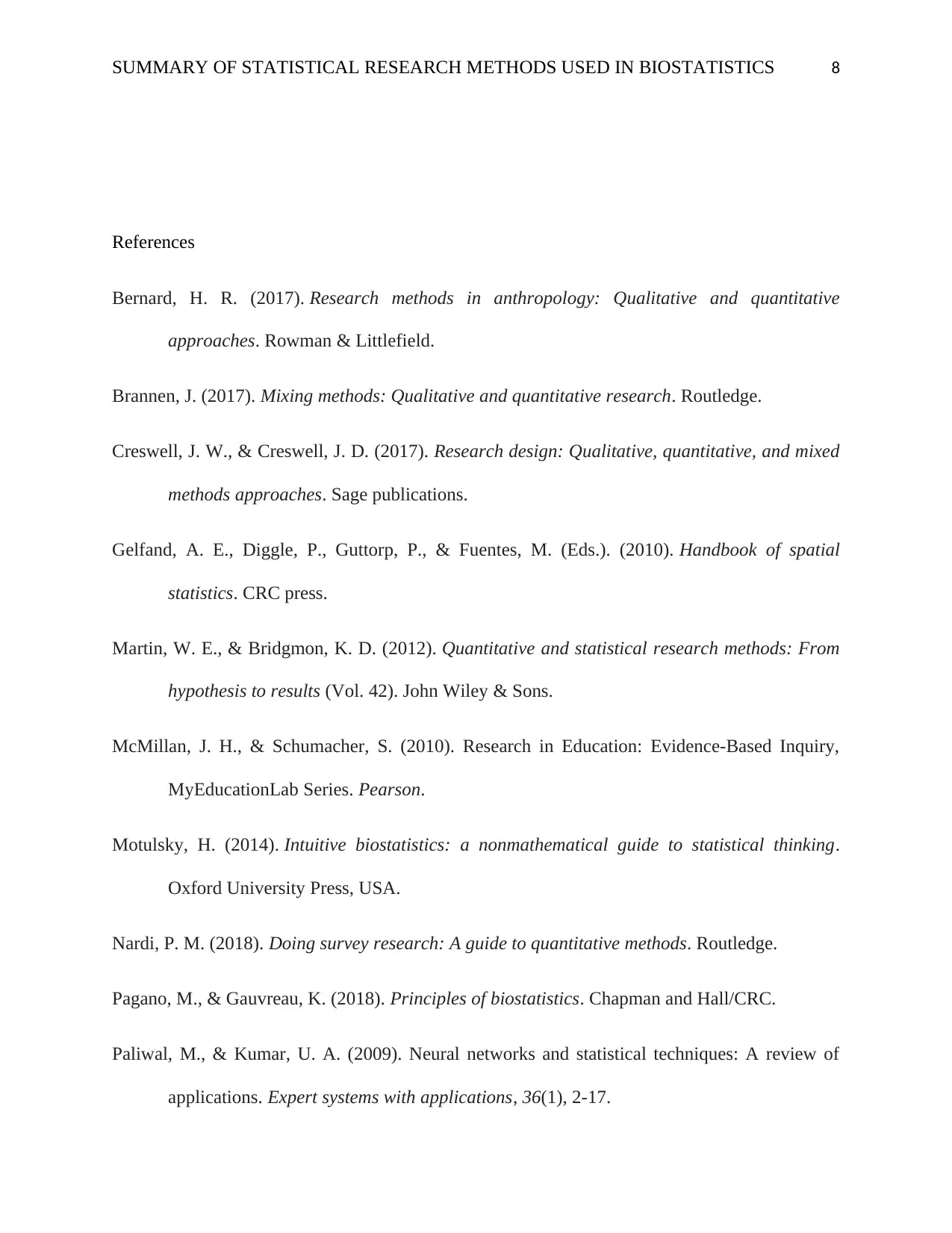
SUMMARY OF STATISTICAL RESEARCH METHODS USED IN BIOSTATISTICS 8
References
Bernard, H. R. (2017). Research methods in anthropology: Qualitative and quantitative
approaches. Rowman & Littlefield.
Brannen, J. (2017). Mixing methods: Qualitative and quantitative research. Routledge.
Creswell, J. W., & Creswell, J. D. (2017). Research design: Qualitative, quantitative, and mixed
methods approaches. Sage publications.
Gelfand, A. E., Diggle, P., Guttorp, P., & Fuentes, M. (Eds.). (2010). Handbook of spatial
statistics. CRC press.
Martin, W. E., & Bridgmon, K. D. (2012). Quantitative and statistical research methods: From
hypothesis to results (Vol. 42). John Wiley & Sons.
McMillan, J. H., & Schumacher, S. (2010). Research in Education: Evidence-Based Inquiry,
MyEducationLab Series. Pearson.
Motulsky, H. (2014). Intuitive biostatistics: a nonmathematical guide to statistical thinking.
Oxford University Press, USA.
Nardi, P. M. (2018). Doing survey research: A guide to quantitative methods. Routledge.
Pagano, M., & Gauvreau, K. (2018). Principles of biostatistics. Chapman and Hall/CRC.
Paliwal, M., & Kumar, U. A. (2009). Neural networks and statistical techniques: A review of
applications. Expert systems with applications, 36(1), 2-17.
References
Bernard, H. R. (2017). Research methods in anthropology: Qualitative and quantitative
approaches. Rowman & Littlefield.
Brannen, J. (2017). Mixing methods: Qualitative and quantitative research. Routledge.
Creswell, J. W., & Creswell, J. D. (2017). Research design: Qualitative, quantitative, and mixed
methods approaches. Sage publications.
Gelfand, A. E., Diggle, P., Guttorp, P., & Fuentes, M. (Eds.). (2010). Handbook of spatial
statistics. CRC press.
Martin, W. E., & Bridgmon, K. D. (2012). Quantitative and statistical research methods: From
hypothesis to results (Vol. 42). John Wiley & Sons.
McMillan, J. H., & Schumacher, S. (2010). Research in Education: Evidence-Based Inquiry,
MyEducationLab Series. Pearson.
Motulsky, H. (2014). Intuitive biostatistics: a nonmathematical guide to statistical thinking.
Oxford University Press, USA.
Nardi, P. M. (2018). Doing survey research: A guide to quantitative methods. Routledge.
Pagano, M., & Gauvreau, K. (2018). Principles of biostatistics. Chapman and Hall/CRC.
Paliwal, M., & Kumar, U. A. (2009). Neural networks and statistical techniques: A review of
applications. Expert systems with applications, 36(1), 2-17.
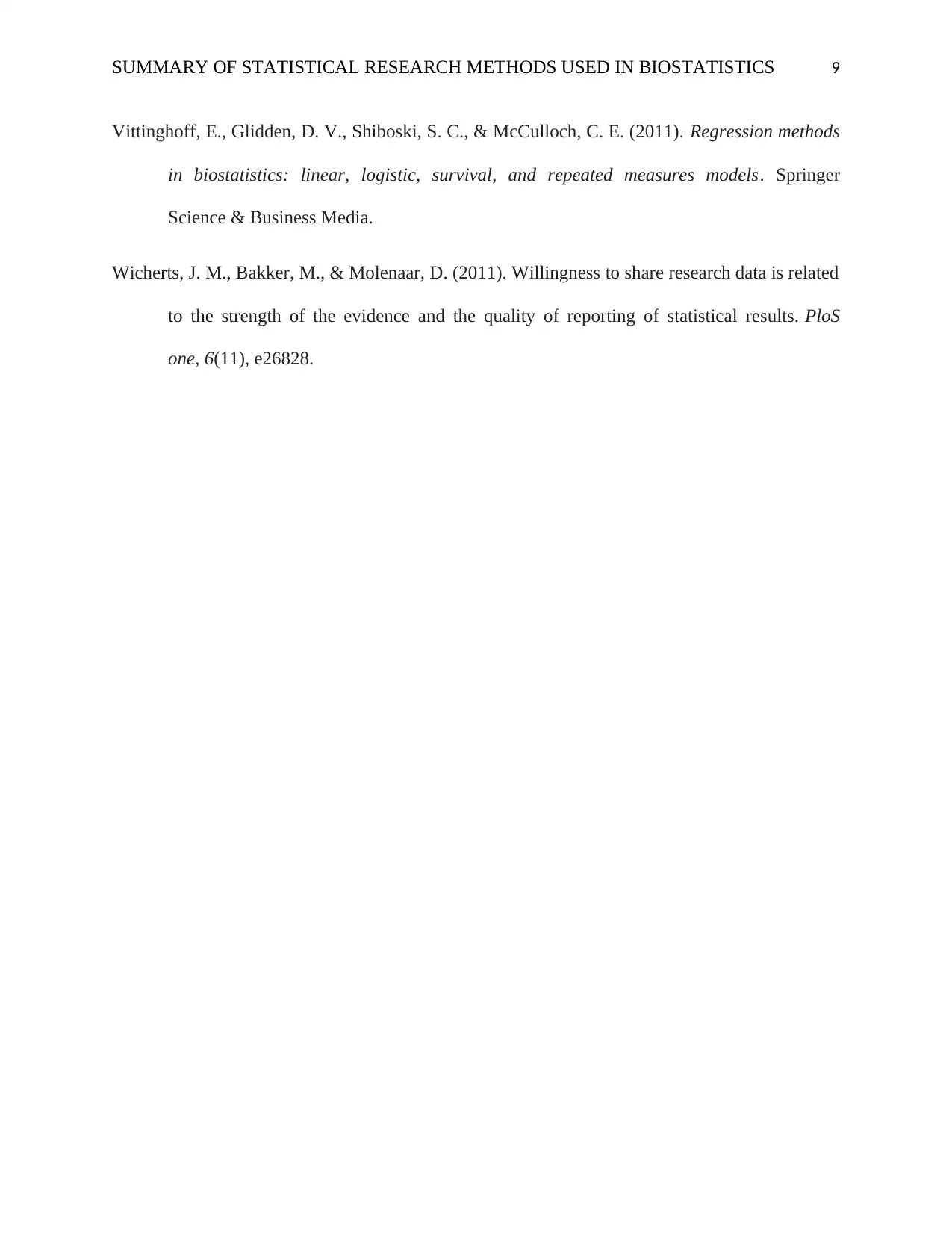
SUMMARY OF STATISTICAL RESEARCH METHODS USED IN BIOSTATISTICS 9
Vittinghoff, E., Glidden, D. V., Shiboski, S. C., & McCulloch, C. E. (2011). Regression methods
in biostatistics: linear, logistic, survival, and repeated measures models. Springer
Science & Business Media.
Wicherts, J. M., Bakker, M., & Molenaar, D. (2011). Willingness to share research data is related
to the strength of the evidence and the quality of reporting of statistical results. PloS
one, 6(11), e26828.
Vittinghoff, E., Glidden, D. V., Shiboski, S. C., & McCulloch, C. E. (2011). Regression methods
in biostatistics: linear, logistic, survival, and repeated measures models. Springer
Science & Business Media.
Wicherts, J. M., Bakker, M., & Molenaar, D. (2011). Willingness to share research data is related
to the strength of the evidence and the quality of reporting of statistical results. PloS
one, 6(11), e26828.
⊘ This is a preview!⊘
Do you want full access?
Subscribe today to unlock all pages.

Trusted by 1+ million students worldwide
1 out of 9
Related Documents
Your All-in-One AI-Powered Toolkit for Academic Success.
+13062052269
info@desklib.com
Available 24*7 on WhatsApp / Email
![[object Object]](/_next/static/media/star-bottom.7253800d.svg)
Unlock your academic potential
Copyright © 2020–2025 A2Z Services. All Rights Reserved. Developed and managed by ZUCOL.




